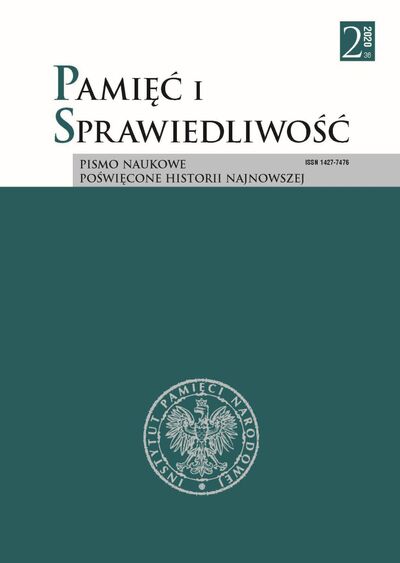“Our solidarity in the struggle is the guarantee of our victory” The Counterintelligence Anti-Terrorist Apparatus in the Eastern Bloc in the 1980s. A Czechoslovak Perspective
Pamięć i Sprawiedliwość, Том 36 № 2 (2020), pages: 449-482
Publication date: 2020-12-31
 https://doi.org/10.48261/PIS203624
https://doi.org/10.48261/PIS203624
Аннотация
At the turn of the 1970s and 80s, the Czechoslovak security apparatus formed an interest in the undercover and espionage activities of the various state security forces in Communist countries in the Eastern Bloc tasked with operations against international terrorism and the training and deployment of special antiterrorist units. Following the establishment of a counterintelligence directorate for “special and unusual types of criminal activity” (the 14th Department of the National Security Corps or SNB), the leadership of the new structure was given the opportunity to make several international study trips to the Soviet Union, Hungary, East Germany, Poland, Bulgaria and even Yugoslavia. Reports from those official visits to security institutions in other Communist countries were filed with the leadership of the Federal Ministry of Internal Affairs. The accounts capture a cross-section view of the status of counterintelligence structures tasked with containing international terrorism (and partly also so-called “domestic” terrorism) in Eastern Europe, including the organisational structures, training programmes and tactics for deploying special antiterrorist units. During those meetings, representatives of the Czechoslovak state security services (Státní Bezpečnost, StB) and public law enforcement and criminal police (Veřejná Bezpečnost, VB) were given access (obviously limited) to information concerning the activities of the 2nd Main Directorate of the KGB (USSR), the 5th Directorate of the KGB (USSR), but also the special Alpha Unit of the 7th Directorate of the KGB (USSR), the 2nd Directorate and the 3rd Main Directorate of the Ministry of Internal Affairs in People’s Republic of Hungary, and the line units of the Revolutionary Regiment of Public Security, the 22nd Main Department of the Ministry of State Security (Hauptabteilung XXII MfS, “Terrorabwehr”) and the special units subordinated to a special working group of the permanent operational staff of the Ministry of State Security (AGM/S MfS) of the German Democratic Republic, the central apparatus of the Polish Security Service, as well as the special security unit in the Main Directorate of the People’s Police, the 2nd Main Directorate in the Ministry of Internal Affairs, People’s Republic of Bulgaria, the special motorised regiment, the federal directorate of counterintelligence at the Secretariat of Internal Affairs, the Socialist Federal Republic of Yugoslavia, and the special anti-terrorist unit of the Militia Brigade. The aim of this article is to serve as a reference work based primarily on the information sourced from Czech archives in order to provide new insights into the collaboration and exchange of information within the Communist Bloc regarding the establishment, training, organisation and, ultimately, deployment of special anti-terrorist units working within the counterintelligence apparatus aimed against the activities of terrorist groups and organisations.
Библиографические ссылки
Archiv Bezpečnostních Složek, Praha – Security Services Archive, Prague
Baev J., Grozev K., “Bulgaria” [in:] A Handbook of the Communist Security Apparatus in East Central Europe, 1944–1989, ed. K. Persak, Ł. Kamiński (Warsaw, 2005).
Boltunov M., «Aľfa» – sverchsekretnyj otrjad KGB (Moscow, 1992).
Childs D., Popplewell R., The Stasi. The East German Intelligence and Security Service (London, 1999).
Das MfS-Lexikon. Begriffe, Personen und Strukturen der Staatssicherheit der DDR (Berlin, 2012).
Gieseke J., “German Democratic Republic” [in:] A Handbook of the Communist Security Apparatus in East Central Europe, 1944–1989, ed. K. Persak, Ł. Kamiński (Warsaw, 2005).
Kalinka W., Schell M., Stasi – nekonečný příběh. Osoby a fakta (Prague, 2005).
Koehler J.O., Stasi. The Untold Story of the East German Secret Police (Boulder, 1999).
Košický P., Žáček P., “Československo-sovětská agenturně operativní spolupráce. StB a KGB proti tzv. ideodiverzním centrum, 1987–1989”, Pamäť národa 2006, no. 3.
Kovář M., Zvláštní jednotky celého světa (Prague, 2014).
Pawlikowicz L., Aparat Centralny 1. Zarządu Głównego KGB jako instrument realizacji globalnej strategii Kremla 1954–1991 (Warsaw, 2013).
Siebenmorgen P., “Staatssicherheit” der DDR. Der Westen im Fadenkreuz der Stasi (Bonn, 1993).
Stehlík E. et al., URNA. 30 let policejní protiteroristické jednotky (Mohelnice, 2011).
Žáček P., “Kontrarozvědný protiteroristický aparát východního bloku v osmdesátých letech dvacátého století”, Sborník Archivu bezpečnostních složek 2017, vol. 15.
Лицензия
Copyright (c) 2023 Pamięć i Sprawiedliwość

Это произведение доступно по лицензии Creative Commons «Attribution-NonCommercial-NoDerivatives» («Атрибуция — Некоммерческое использование — Без производных произведений») 4.0 Всемирная.
https://creativecommons.org/licenses/by-nc-nd/4.0
Наиболее читаемые статьи этого автора (авторов)
- Pavel Žáček, The Czechoslovak Little Sister: A brief overview of the organizational development of the foreign intelligence service in Communist Czechoslovakia, 1953–1989 , Pamięć i Sprawiedliwość: Том 30 № 2 (2017)
- Andrzej Grajewski, Pavel Žáček, [Recenzja] Pavel Žáček, Boje o minulost. Deset let vyrovnáváni se s komunistickou minulosti – pokus o předbĕžnou bilanci, Barrister and Principal, Brno 2000 , Pamięć i Sprawiedliwość: Том 3 № 1 (2003)
 Język Polski
Język Polski
 English
English
 Deutsch
Deutsch
 Français (France)
Français (France)
 Italiano
Italiano
 Русский
Русский


 PDF (English)
PDF (English)




